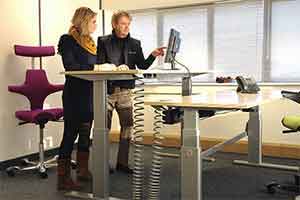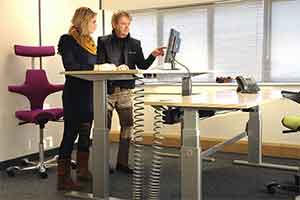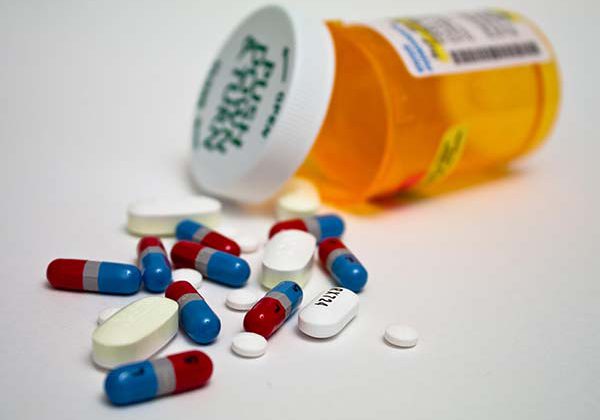Interrupting sitting time improves blood sugar control in people with type 2 diabetes

A new study published in Diabetologia (the journal of the European Association for the Study of Diabetes [EASD]) suggests that a ‘Sit Less’ intervention – breaking sitting with standing and light-intensity walking – may be an alternative to structured exercise to promote blood sugar control in patients with type 2 diabetes, giving improved 24-hour glucose levels and improved insulin sensitivity.
 The use of moderate to vigorous exercise is one of the cornerstones of prevention and treatment of type 2 diabetes, with current physical activity guidelines recommending a performance of at least 150 min per week of exercise at these intensities. Despite the proven effectiveness of such a regime, however, over 90% of the healthy population does not adhere to the guidelines. Non-compliance is likely to be even higher in those with type 2 diabetes, in which related comorbidities such as muscle weakness and peripheral neuropathy can be a barrier to physical exercise. An alternative approach is needed.
The use of moderate to vigorous exercise is one of the cornerstones of prevention and treatment of type 2 diabetes, with current physical activity guidelines recommending a performance of at least 150 min per week of exercise at these intensities. Despite the proven effectiveness of such a regime, however, over 90% of the healthy population does not adhere to the guidelines. Non-compliance is likely to be even higher in those with type 2 diabetes, in which related comorbidities such as muscle weakness and peripheral neuropathy can be a barrier to physical exercise. An alternative approach is needed.
This study considered the possible benefits of a ‘Sit Less’ programme, replacing sitting time with standing and light-intensity walking, in comparison to the use of a conventional structured exercise regimen of the same energy expenditure. It was conducted by Bernard Duvivier, Department of Human Biology and Movement Science, NUTRIM School for Nutrition and Translational Research in Metabolism, Maastricht University Medical Centre+, Netherlands, and colleagues.
The study involved 19 adults (13 men and 6 women) with type 2 diabetes, with a mean disease duration of 6 years, a mean HbA1c of 6.7% and a mean fasting plasma glucose of 7.88 mmol/l during screening. Their mean age was 63 years and the mean BMI was 30.5 kg/m2 (just within the definition of obese). A total of 14 participants were using glucose-lowering diabetes drugs and 13 were using lipid-lowering drugs (most often statins).
The participants followed three activity regimens – ‘Sitting’, ‘Exercise’ and ‘Sit Less’ – each lasting 4 days. During the sitting regimen participants were restricted to 1 hour/day of walking and 1 hour/day standing, with the remaining 14 hours spent sitting. During the exercise regimen approximately 1 hour/day of sitting time was replaced by supervised cycling on an ergometer at the research centre, in 20 minute bouts separated by 5 minutes rest. In the sit less regimen, 5 hours/day sitting were replaced by 2 hours walking and 3 hours standing, with participants encouraged to break up their sitting time every 30 minutes with small bouts of walking and standing throughout the day. The exercise and sit less regimens were designed to have comparable energy expenditure for each participant. The order of the regimens was randomised, and 10 days of usual lifestyle was maintained as a ‘wash-out’ period before and between regimens.
Diet was controlled with use of the participants’ normal diet, supplemented during the last 36 hours of each regimen by the provision of pre-packed meals based on their energy requirements for each regimen. Glucose levels were measured continuously using a subcutaneous glucose monitor and also via the collection of blood glucose samples four times daily. The use of light-intensity walking was diarised and verified using advanced accelerometry (which monitors motion via multiple parameters). 24-hour glucose levels were analysed during the last 24 hours of each four-day regimen. On the day after each regimen, between 08.30 and 09.30 hours, after an overnight fast, blood was collected for glucose, insulin and lipid measurements.
The data were analysed to provide: 24 hour glucose concentration; incremental AUC for glucose (incremental area under the curve – a summary measure of glucose usage – the increase above fasting level over 24 hours); duration of hyperglycaemia; an average glucose concentration for each 30 minutes to indicate any bouts of hypoglycaemia; an estimate of insulin sensitivity; fasting triacylglycerol levels and non-esterified fatty acid (NEFA) levels.
The study found that the use of the sit less regimen led to significant improvements in insulin sensitivity, mean 24-hour glucose levels, 24-hour glucose excursions, durations of hyperglycaemia and fasting triacylglycerol levels, compared with sitting. Whilst positive effects for most variables (other than 24-hour glucose) were also found in the traditional exercise regimen, these were generally less potent than the improvements found for the sit less group. In addition, glucose level reductions, which can lead to hypoglycaemia and render some diabetic patients reluctant to perform structured exercise, were found to be less for the sit less regimen.
Previously it has been noted that a sedentary (inactive) lifestyle is associated with an increased risk of type 2 diabetes, and that regular interruption of sitting using small bouts of walking may be beneficial to insulin action and glucose control. This study, however, is the first to consider the effects of a sit less regimen for people with type 2 diabetes in free-living conditions. The outcome of the study fits the emerging picture that breaking up sedentary behaviour by light-intensity activities may be a potent way to help improve blood glucose control.
The authors suggest that sustained compliance with exercise programmes, especially by individuals with type 2 diabetes, is at best mediocre. Strategies to reduce sitting time are generally considered to be less demanding than structured exercise programmes and hence are more likely to have long-term compliance. The authors say that their findings “provide indications favouring the implementation of interventions targeting the breaking-up of sitting time over interventions involving structured exercise”. As the volume of activities in this proof-of-concept study was high (an additional 2 hours walking and 3 hours standing during the sit less regimen in comparison to the other regimens), the authors suggest “that future long-term studies are needed to determine the volume of light-intensity activity that is feasible in daily life”.




